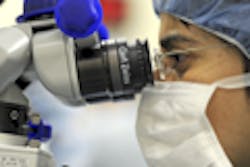Detection methods for prevention of early-onset neonatal group B strep infections
Group B Streptococcus (GBS) remains a leading cause of neonatal infections, with very severe outcomes. Infections are acquired through vertical transmission from a GBS-colonized mother before delivery, during prolonged labor or premature rupture of membranes, during passage through the birth canal, or by post-partum exposure. Neonates exposed to GBS may develop symptoms of rapidly invasive disease including sepsis, pneumonia, and meningitis within the first week after birth (early-onset disease) or after a week and up to three months of life (late-onset disease). Intrapartum antibiotic prophylaxis for GBS-colonized women during labor reduces transmission and the risk of early onset neonatal disease 1,2
Prevention strategies
Prevention efforts for early-onset neonatal GBS disease focus on identifying women for whom prophylaxis during labor is appropriate. Risk factors include maternal intrapartum GBS colonization, a previous GBS-infected baby, positive for GBS in urine (bacteruria) in any trimester of current pregnancy, delivering at <37 weeks’ gestation, having an intrapartum temperature ≥38.0°, or membrane rupture for ≥18 hours, and intrapartum women with any of these are given antibiotic prophylaxis.1,2 In the United States, universal culture-based screening for GBS colonization is also done for all pregnant women between 35 and 37 weeks of gestation, and prophylaxis is given to colonized women.1Prevention strategies have led to an appreciable decline in the incidence of early-onset GBS disease.3-5 However, despite their positive impact, neonatal GBS infections still occur, which highlights significant gaps in identifying those at risk of early-onset infection. In a recent analysis, only 58 percent of mothers with infants who developed early onset GBS disease were screened for GBS (63 percent full term and 44 percent pre-term), and 81 percent of term mothers who were screened had a negative GBS culture result. This suggests that a change in colonization status of women at the time of birth or a less-than-optimal GBS detection method may have contributed to these cases.6
Traditional detection methods
Accurate and timely identification of GBS carriage is essential for appropriate prophylactic treatment during labor. The current standard for GBS detection in pregnant women is broth enrichment culture of a vaginal/rectal swab, which is central to the universal culture-based GBS screening strategy.1 Direct culture is unreliable as it misses many women who are GBS carriers. Selective enrichment broths for GBS are variations of Todd-Hewitt broth, with either 8 µg/mL gentamicin and 15 µl/mL nalidixic acid (TransVag broth) or 10 µg/mL colistin and 15 µl/mL nalidixic acid (Lim broth).1,7 The enriched broth is sub-cultured on blood agar plates, and presumptive isolated GBS colonies are identified by a characteristic narrow zone of ß-hemolysis, followed by confirmation by standard phenotypic methods (e.g., CAMP test ) or serological tests (e.g., agglutination with GBS antiserum).7 The downside is that culture methods have a long turnaround time (TAT) of 24 to 72 hours, which could result in delayed prophylaxis or unnecessary treatment of the infant. This precludes use of culture for intrapartum GBS screening, and it is typically performed during prenatal or antepartum screening at 35 to 37 weeks gestation.
Chromogenic media which depend on the ability of ß-hemolytic GBS to produce a visible orange carotenoid pigment (granadaene) offer good options for GBS culture in clinical laboratories.8,9 However, ~five percent to eight percent of GBS isolates are non-hemolytic, and some also do not produce granadaene, making detection by culture difficult.10 Consequently, women colonized with these strains may be missed and, in the absence of appropriate prophylaxis, pose significant risk for development of neonatal sepsis.
Molecular testing
Molecular methods have raised the bar for accurate and definitive results for detection of GBS in less time than culture, but they also raise important questions about their use for timely intervention and intrapartum prophylaxis for colonized women. DNA hybridization probe assays were the earliest methods developed for detection of GBS in vaginal/rectal swabs11 but were gradually replaced by nucleic acid amplification tests (NAATs), which are more sensitive, simplified, and based on polymerase chain reaction (PCR) or novel technologies such as loop-mediated isothermal amplification (LAMP) and helicase-dependent amplification (HDA).
Most commercial GBS NAATs are performed with 18-to-24-hour broth-enriched specimens, which is consistent with GBS screening recommendations for prevention of neonatal disease. These assays have excellent sensitivities, from 95 percent to 99 percent, compared to broth-enriched culture methods,12,13 and demonstrate similar performance with 97 percent to 98 percent overall agreement.14,15 The performance of NAATs with non-enriched specimens is variable, with sensitivities from ~63 percent to 99 percent compared to broth enriched culture.1 A more recent study of a GBS NAAT designed for direct testing of vaginal/rectal swab specimens showed an inferior performance (86 percent sensitivity) compared to two broth-enriched molecular PCR tests, with 97 percent and 99 percent sensitivities, respectively.13 A summary of studies assessing NAAT’s performance at antepartum or intrapartum, with antepartum enriched broth enriched culture as the reference, shows mixed results, but mostly supports the conclusion that NAAT sensitivity is significantly improved with broth enrichment culture.1
A roadblock to widespread adoption of NAATs for detection of GBS carriage is that, despite their simplicity and rapid assay turnaround time (one to four hours), the need for a pre-enrichment step to maximize sensitivity prevents their use in identifying GBS carriers for prophylaxis during labor. Furthermore, laboratories contend that with NAATs, an isolate may not be recoverable for antimicrobial susceptibility testing, which is required to guide the treatment of penicillin-allergic women at high risk for anaphylaxis. Despite these limitations, however, rapid GBS NAATs with a TAT of at least one hour are increasingly considered for use in emergent cases where the GBS colonization status of a pregnant woman is unknown or other risk factors such as pre-term labor exist, and allow for selective intrapartum antibiotic prophylaxis for individuals identified as GBS carriers.
As molecular technologies continue to evolve, it is reasonable to expect that NAATs or more sophisticated methods will emerge as the standard for detection of GBS carriage at intrapartum in the near future. They may even replace culture for diagnosis of suspected cases of neonatal GBS sepsis as test sensitivity improves.
REFERENCES
- Verani JR, McGee L, Schrag SJ. Prevention of perinatal group B streptococcal disease: revised guidelines from CDC, 2010. MMWR Recomm Rep. 2010;59(RR-10):1-36.
- Royal College of Obstetricians & Gynaecologists. 2012 Guideline No. 36. The Prevention of Early-Onset Neonatal Group B Streptococcal Disease. https://www.rcog.org.uk/en/guidelines-research-services/guidelines/gtg36/.
- Lukacs SL, Schrag SJ. Clinical sepsis in neonates and young infants, United States, 1988–2006. J Pediatr. 2012;160(6):960-5 e1.
- Van Dyke MK, Phares CR, Lynfield R, et al. Evaluation of universal antenatal screening for group B Streptococcus. NEJM. 2009;360(25):2626-36.
- Darlow B, Voss L, Lennon D, Grimwood K. Early-onset neonatal group B Streptococcus sepsis following national risk-based prevention guidelines. ANZ Obs Gyn. 2016;56:69-74.
- Stoll BJ, Hansen NI, Sanchez PJ, et al. Early onset neonatal sepsis: the burden of group B Streptococcal and E. coli disease continues. Pediatrics. 2011;127(5):817-826.
- Manual of Clinical Microbiology, 11th Edition. K.C. Carroll, G. Funke, J.H. Jorgenson, M.L. Landry, S.S. Richter and D.W. Warnock. Editors In Chief: J.H Jorgensen, M.P. Pfaller. American Society for Microbiology Press. Washington DC, 2015.
- Church D, Baxter H, Lloyd T, Miller B, Elsayed S. Evaluation of Strep B Carrot broth versus Lim broth for detection of group B Streptococcus colonization status of near-term pregnant women. J Clin Microbiol. 2008:46:2780-2782.
- Tazi A, Reglier-Poupet H, Dautezac F, Raymond J, Poyart C. Comparative evaluation of Strepto B ID chromogenic medium and Granada media for the detection of group B Streptococcus from vaginal samples of pregnant women. J Microbiol Methods. 2008;73:263-265.
- Nickmans S, Verhoye E, Boel A, Van Vaerenbergh K, De Beenhouwer H. Possible solution to the problem of nonhemolytic group B Streptococcus on Granada medium. J Clin Microbiol. 2012;50:1132–1133.
- Bourbeau P, Heiter B, Figdore M. Use of Gen-Probe Accuprobe Group B Streptococcus test to detect group B streptococci in broth cultures of Vaginal-Anorectal specimens from pregnant women: Comparison with traditional culture method. J Clin Microbiol. 1997;35:144-147.
- Riedlinger J, Beqaj SH, Milish MA, et al. Multicenter evaluation of the BD Max GBS assay for detection of group B streptococci in prenatal vaginal and rectal screening swab specimens from pregnant women. J Clin Microbiol. 2010;48:4239-4241.
- Buchan, B, Faron M, Fuller D, Davis T, Mayne D, Ledeboer N. Multicenter clinical evaluation of the Xpert GBS LB assay for detection of group B Streptococcus in prenatal screening specimens. J Clin Microbiol. 2015;53:443-448.
- Couturier BA, Weight T, Elmer H, Schlaberg R. Antepartum screening for group B Streptococcus by three FDA-cleared molecular tests and effect of shortened enrichment culture on molecular detection rates. J Clin Microbiol. 2014 52(9):3429 –3432.
- Miller S, Deak E, Humphries R. Comparison of the AmpliVue, BD Max System, and illumigene molecular assays for detection of Group B Streptococcus in antenatal screening specimens. J Clin Microbiol. 2015;53(6):1938-1941.
Diane Kawa, PhD, serves as Director of Scientific Affairs for BD Life Sciences—Diagnostics Systems, manufacturer of the BD MAX System.

